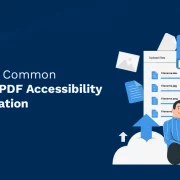
Balancing Learner Engagement with Learning Effectiveness
Summary
This blog discusses the growing digital learning industry in India, the importance of learner engagement for effectiveness, and how companies like Hurix Digital design interactive platforms that drive performance outcomes.
In an accelerated Internet economy such as India, digital learning is continuing to grow and fast becoming a mainstream format for learning. The CAGR for the e-learning industry is pegged at 13.9% between 2022 and 2027.
Access to affordable data and smart devices and early investments in raising the quality of digital learning has accelerated this growth. However, consumer aspirations have also evolved, with more learners wanting an interactive, hands-on approach to learning.
Unlike in classroom lecture-style formats, learner engagement has, in fact, emerged as a core metric by which the success of digital learning is being measured. However, the success of the model extends beyond active engagement.
In a vibrant conversation hosted by Balasubbhramaniyam Ayyaswaami, Associate Vice President of Marketing at Hurix Digital, an expert panel of veterans from Hurix comprising Madhavi Diwale, Senior Director of Learning Strategy and Design; Surabhi Sharma, Associate Director of Instructional Design; and Gagandeep Kaur, Senior Manager of Instructional Design, broke down the basics of learner engagement, and how it can drive learning effectiveness.
Table of Contents:
- Learner Engagement Defined
- Learning Needs vs. Aspirations
- Problem-Solving for Performance Outcomes
- Designing for Learning Success
- The Relevance of Interactivity
- Measuring Engagement
- The Takeaway
Learner Engagement Defined
Learner engagement encompasses how active learners are during the course of pursuing an online program.
Creators of digital learning platforms, tools, and systems are continuously working on raising learner engagement. However, it is not enough for learners to be engaged. According to Madhavi Diwale, Senior Director of Learning Strategy and Design at Hurix Digital, the term has taken on a different meaning in recent times.
“Slick visuals, animations, gamification, augmented reality – while these are eye-catching, enjoyable aspects of engagement, driven by technology, it does not mean that they are effective. We leverage technology to scale learning for a larger audience, but we must always keep an eye on whether it is really effective in driving performance outcomes. For this, learners must be engaged at a more cerebral level,” observes Madhavi.
Learning Needs vs. Aspirations
While it is ideal for learners to be immersed in the learning process, a large portion of workforce training is a mandatory requirement for workers for it to be considered effective. Hence, the interest levels of learners are already low when they enter the learning environment.
“While many come to the training because they need to, we want learners to complete it because they want to. The bridge between the need and want is what we aim to build through learner engagement,” explained Surabhi Sharma, Associate Director of Instructional Design at Hurix Digital.
Also Read: What is an eLearning Module? Know the Benefits, Challenges & Future of eLearning Modules
Problem-Solving for Performance Outcomes
According to Madhavi, businesses often attempt to problem-solve for specific performance goals by offering interactive learning modules to their employees.
“We have clients who believe that by leveraging technologies such as virtual reality, the performance gap can be addressed,” she reflects. However, the performance problem has to be mapped to the right solution for the exercise to be successful. This is where the expertise of learning solution providers like Hurix can bring in a unique insight to support businesses.
Surabhi recollects a specific incident where a popular logistics business came in with a requirement to help train their entry-level employees working on data-entry roles. “The job seems simple, but even a small error can lead to lots of dollars being expended in the form of fines and penalties,” she recalls.
The ask by the logistics company was straightforward – design a game that would work for the millennial workforce. However, there was no time spent on analysis. “When we understood the business context and the KPIs involved, we designed an effective training that was not game-based, yet, delivered results,” she says.
Designing for Learning Success
The ultimate goal of any learning platform is the transfer of knowledge and skills, and design plays a key role in enabling learning. There is a need to engage learners at a deeper cognitive level, according to Gagandeep Kaur, Senior Manager of Instructional Design at Hurix Digital. “You can top that up by engaging them on a social and emotional level as well,” she observes.
Higher behavioral engagement displayed by learners indicates that they are making a conscious effort to learn. But how do you understand if the transfer of knowledge is actually happening? One approach is to include a grading system through regular assessments. Good grades indicate a positive learning curve.
The design of the learning platform must also facilitate an opportunity for meaningful feedback and discussions, around learning. These are some approaches to helping learners track their progress.
The Relevance of Interactivity
Interactivity is an aspect of learning engagement. However, an overdose of interactivity can also kill engagement, according to Surabhi. “It’s like garnishing a dish – it has to be just the right amount and relevant, ” she observes. Too much interactivity without relevance can result in cognitive overload.
Gagandeep offers an insight into how interactivity must be viewed. She gives examples of millennials who display lower attention spans as compared to earlier generations.
“Logically, smaller nuggets that are spaced out would work. A mix of videos, e-reads, and other formats, offer variation and keep the learner interested,” she explains.
Also Read: The Essentials of eLearning: Getting Started with Online Training
Measuring Engagement
Measuring the success of a learning program is an important aspect of the entire process, and Madhavi enlightens us on how it works.
Standard industry practice is to evaluate learning programs at four levels:
- Reactions are measured by sending surveys to participants after they complete the program
- Assessments are to evaluate if learning has taken place at different levels
- Behaviour is measured through on-the-job performance
- Results comprise forming a correlation between the learning program and business results.
“This is a complex and lengthy process, but it can be done,” shares Madhavi.
The Takeaway
Along with training needs and performance goals, the learning audience must also be understood when designing a digital learning program. A seasoned, knowledgeable, and committed digital learning partner like Hurix Digital can help companies build engaging learning programs that are effective and deliver tangible and measurable results.
Connect with us to start a conversation on how to make your workforce future-ready.

Senior Vice President
A Business Development professional with >20 years of experience with strong capability to sell new solutions and develop new markets from scratch. New Market Entry Specialist with experience of working in two of the largest emerging markets – China & India. Also covered other key markets in APAC, US, EU & ME. Exceptional experience of conceptualizing, ideating and selling new learning technologies like VR AR, etc. across multiple industry verticals.






